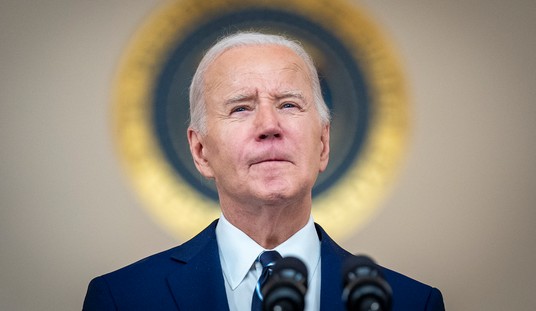With Ted Cruz wrapping up his 20-hour-plus marathon speech against ObamaCare in the Senate debate over the continuing resolution to keep government funded, Senate Republicans still have to deal with the upcoming fight on raising the debt limit. They want to force Barack Obama to negotiate on some kind of debt-reduction change as the price of allowing it to pass, even though Obama insists he won’t negotiate at all. The solution? Give Obama what he wants … or at least claims to support:
Senate Republicans have a strategy for lifting the U.S. borrowing limit: offer what PresidentBarack Obama asked for in his budget, then dare him to refuse.
These lawmakers, looking beyond an effort to derail the president’s health-care law, see the possibility of replacing automatic cuts to federal programs with reductions to entitlement spending. Among these: Obama’s proposal to trimSocial Security cost-of-living increases that would save about $130 billion over 10 years.
“Since the president himself has proposed some of these things, it would seem logical that he would not turn that down,”John Cornyn, the Senate’s No. 2 Republican, said in an interview.
The approach is aimed at gaining enough Democratic support in the Senate to force Obama, who said he won’t negotiate on the debt limit, to accept changes that he has called “manageable” as a first step to shoring up Social Security and Medicare. Republicans also would score a victory that would provide balance to lifting the debt ceiling, something their party base opposes.
A move to chained CPI as a budget reform is not new. In fact, Senator Bob Corker offered a similar deal in December 2012 as a way to break an impasse on budget negotiations after the election. At the time, Obama didn’t bite on the proposal, but four months later Obama proposed the move to chained CPI in exchange for tax hikes. That infuriated some Democrats, who didn’t want Obama legitimizing the reform in how inflation gets calculated for the purposes of cost-of-living increases in Social Security.
Why not? National Journal explained in December:
Here’s how the new metric would save money: Social Security, federal pensions, and military and veterans’ benefits are indexed to rise each year with inflation; so are tax brackets, exemptions, deductions, and credits. But experts say the consumer price index the government currently uses overstates how rising prices affect household spending.
The Bureau of Labor Statistics has come up with a more accurate measure, which accounts for consumers’ tendency to switch to cheaper categories of products when prices rise. Rather than looking at a fixed set of goods—as the standard formula does—the new measure looks at how the set of goods changes, and then “chains” two consecutive months of consumption data together.
The chained CPI rises a little more slowly than the current measure. So if the chained CPI were used to calculate cost-of-living increases, it would mean smaller increases to Social Security checks each year. If the chained CPI were applied to the tax code, it would move taxpayers into higher tax brackets faster.
Opponents of the chained CPI say that it would unnecessarily cut Social Security and other benefit programs, burden the oldest and sickest Americans, and hit almost everyone with a tax increase. The deficit-reduction plans floating around Washington—such as the Simpson-Bowles plan—recommend that a switch to chained CPI involves additional protections for the most-vulnerable beneficiaries.
First, though, the Senate Republican caucus needs to repair the breaches in its unity that have erupted over the last few weeks on the CR fight. David Drucker reports that the GOP caucus held a closed-door meeting yesterday while Cruz started his marathon speech:
“We’re totally unified in wanting to repeal Obamacare, we’d all like to see it defunded. And so it’s, how can you develop a unified strategy, a unified position that puts us back on the high ground of talking about how harmful Obamacare is going to be,” Sen. Ron Johnson, R-Wis., said upon exiting the meeting. “Those are the issues we ought to be discussing rather than interparty squabbles.”
Sources familiar with the meeting said that about a dozen or so senators spoke during the private Republican gathering, which included a discussion about parliamentary procedure and options for how to approach the continuing resolution approved by the House last Friday. The package defunds the Affordable Care Act, President Obama’s prized legislative achievement, but would ensure that the government has enough money to continue operating through Dec. 15. …
Sen. Roy Blunt, R-Mo., the conference vice chairman and an opponent of the Cruz-Lee strategy to leverage a government shutdown in an attempt to defund Obamacare, speculated that the most of the minority caucus could unify over the next few days. Only 15 senators are signatory to the Lee letter vowing not to support a government funding bill that includes money for the Affordable Care Act.
Cruz hasn’t exactly been conciliatory during his speech, but once the CR issue has become moot, there may be room to dial back and unite on a new project. If the House sends a CR with a one-year delay in it, that will give the Senate GOP caucus a good opportunity to link arms and demand that red-state Democrats act to protect their constituents against a disastrous rollout. Meanwhile, the debt-ceiling strategy acts directly on a key issue for rising national debt, and defies Obama to reject his own proposal as a compromise on raising the debt ceiling. Both should put Democrats back squarely on defense, which is why Obama angered his colleagues with the April proposal.








Join the conversation as a VIP Member